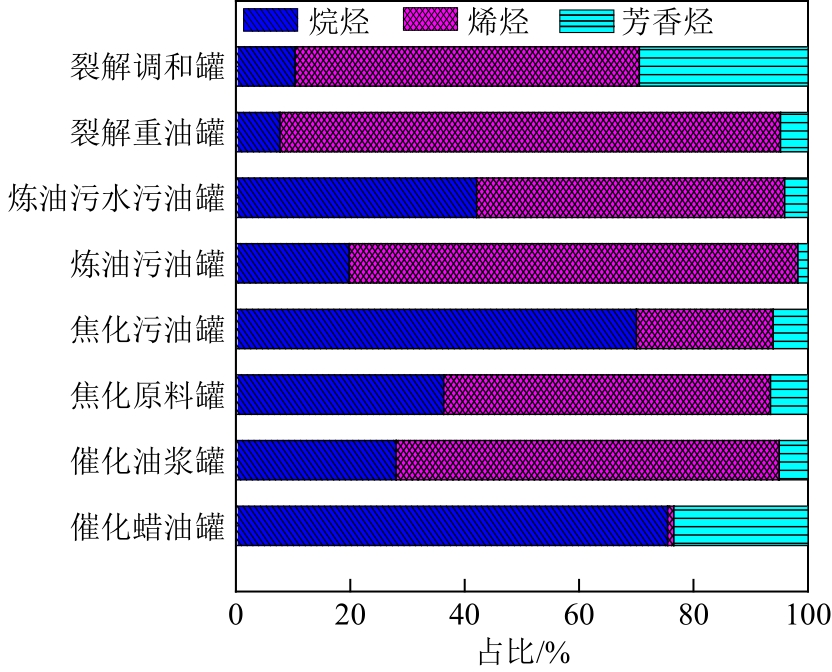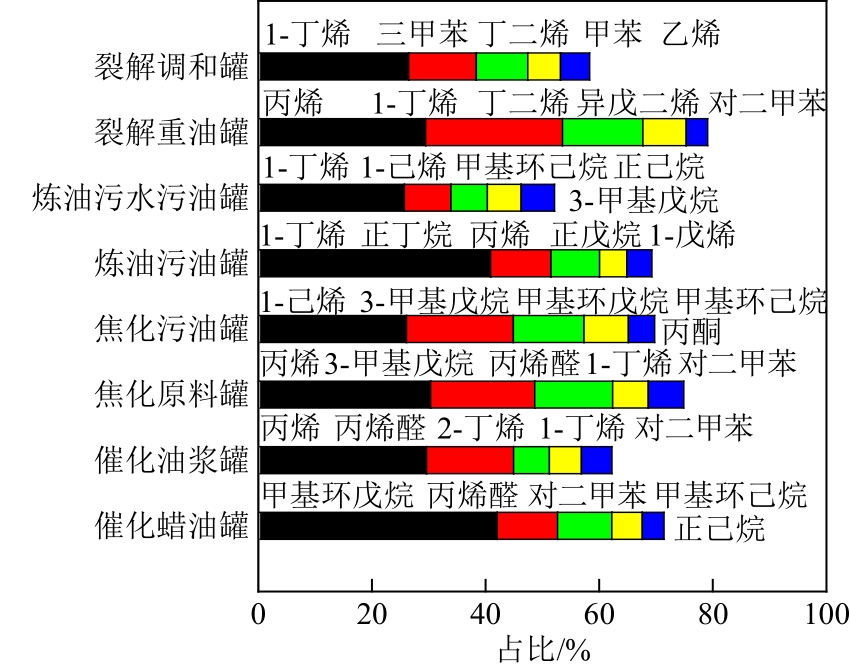| 1 |
中华人民共和国生态环境部. 2019中国生态环境状况公报[R]. 北京: 生态环境部, 2020.Ministry of Ecology and Environment of the People’s Republic of China. 2019 Bulletin on the state of ecology and environment in China[R]. Beijing: MEE, 2020.
|
| 2 |
ATKINSON R. Atmospheric chemistry of VOCs and NO x [J]. Atmospheric Environment, 2000, 34(12/13/14): 2063-2101.
|
| 3 |
ZIEMANN P J, ATKINSON R. Kinetics, products, and mechanisms of secondary organic aerosol formation[J]. Chemical Society Reviews, 2012, 41(19): 6582-6605.
|
| 4 |
余益军, 孟晓艳, 王振, 等. 京津冀地区城市臭氧污染趋势及原因探讨[J]. 环境科学, 2020, 41(1): 106-114.
|
|
YU Yijun, MENG Xiaoyan, WANG Zhen, et al Driving factors of the significant increase in surface ozone in the Beijing-Tianjin-Hebei region, China, during 2013—2018[J]. Environmental Science, 2020, 41(1): 106-114.
|
| 5 |
王杨君, 李莉, 冯加良, 等. 基于OSAT方法对上海2010年夏季臭氧源解析的数值模拟研究[J]. 环境科学学报, 2014, 34(3): 567-573.
|
|
WANG Yangjun, LI Li, FENG Jialiang, et al. Source apportionment of ozone in the summer of 2010 in Shanghai using OSAT method[J]. Acta Sciencae Circumstantiae, 2014, 34(3): 567-573.
|
| 6 |
WANG Tao, XUE Likun, BRIMBLECOMBE P, et al. Ozone pollution in China: a review of concentrations, meteorological influences, chemical precursors, and effects[J]. Science of the Total Environment, 2017, 575: 1582-1596.
|
| 7 |
WANG Mengya, YIM S H L, WONG D C, et al. Source contributions of surface ozone in China using an adjoint sensitivity analysis[J]. Science of the Total Environment,2019, 662: 385-392.
|
| 8 |
LI Lingyu, XIE Shaodong, ZENG Limin, et al. Characteristics of volatile organic compounds and their role in ground-level ozone formation in the Beijing-Tianjin-Hebei region, China[J]. Atmospheric Environment, 2015, 113: 247-254.
|
| 9 |
潘本锋, 程麟钧, 王建国, 等. 京津冀地区臭氧污染特征与来源分析[J]. 中国环境监测, 2016, 32(5): 17-23.
|
|
PAN Benfeng, CHEN Linjun, WANG Jianguo, et al. Characteristics and source attribution of ozone pollution in Beijing-Tianjin-Hebei region[J]. Environmental Monitoring in China, 2016, 32(5): 17-23.
|
| 10 |
CHEN Shenpo, WANG Chiheng, LIN Wendian, et al. Air quality impacted by local pollution sources and beyond-using a prominent petro-industrial complex as a study case[J]. Environmental Pollution, 2018, 236: 699-705.
|
| 11 |
CETIN E, ODABASI M, SEYFIOGLU R. Ambient volatile organic compound (VOC) concentrations around a petrochemical complex and a petroleum refinery[J]. Science of the Total Environment, 2003, 312(1/2/3): 103-112.
|
| 12 |
吴亚君, 胡君, 张鹤丰, 等. 兰州市典型企业VOCs排放特征及反应活性分析[J]. 环境科学研究, 2019, 32(5): 802-812.
|
|
WU Yajun, HU Jun, ZHANG Hefeng, et al. Characteristics and chemical reactivity of fugitive volatile organic compounds from typical industries in Lanzhou city[J]. Research of Environmental Sciences, 2019, 32(5): 802-812.
|
| 13 |
刘锦, 王秀艳, 杨文, 等. 天津临港石化企业VOCs排放特征及环境影响[J]. 环境科学研究, 2018, 31(2): 215-220.
|
|
LIU Jin, WANG Xiuyan, YANG Wen, et al. Emission characteristics and environmental impact of VOCs in Tianjin Lingang petrochemical enterprises[J]. Research of Environmental Sciences, 2018, 31(2): 215-220.
|
| 14 |
李凌波, 李龙, 程梦婷, 等. 石化企业挥化性有机物无组织排放监测技术进展[J]. 化工进展, 2020, 39(3): 1196-1208.
|
|
LI Lingbo, LI Long, CHENG Mengting, et al. Current status and future developments in monitoring of fugitive VOC emissions from petroleum refining and petrochemical Industry[J]. Chemical Industry and Engineering Progress, 2020, 39(3): 1196-1208.
|
| 15 |
WEI Wei, CHENG Shuiyuan, LI Guohao, et al. Characteristics of ozone and ozone precursors (VOCs and NO x ) around a petroleum refinery in Beijing, China[J]. Journal of Environmental Sciences, 2014, 26(2): 332-342.
|
| 16 |
SONG Yu, DAI Wei, SHAO Min, et al. Comparison of receptor models for source apportionment of volatile organic compounds in Beijing, China[J]. Environment Pollution, 2008, 156(1): 174-183.
|
| 17 |
HUANG C, CHEN C H, LI L, et al. Emission inventory of anthropogenic air pollutants and VOC species in the Yangtze River Delta region, China[J]. Atmospheric Chemistry and Physics, 2011, 11(9): 4105-4120.
|
| 18 |
WU Rongrong, BO Yu, LI Jing, et al. Method to establish the emission inventory of anthropogenic volatile organic compounds in China and its application in the period 2008—2012[J]. Atmospheric Environment, 2016, 127:244-254.
|
| 19 |
李凌波, 刘忠生, 方向晨. 炼油厂VOC排放控制策略——储运、废水处理、工艺尾气、冷却塔及火炬[J]. 当代石油石化, 2013, 21(10): 4-12.
|
|
LI Lingbo, LIU Zhongsheng, FANG Xiangchen.The strategies for refinery VOC emission control—Storage tanks and transfer operations, wastewater treatment, process vents, cooling towers and flares[J]. Petroleum & Petrochemical Today, 2013, 21(10): 4-12.
|
| 20 |
WEI Wei, CHENG Shuiyuan, LI Guohao, et al. Characteristics of volatile organic compounds (VOCs) emitted from a petroleum refinery in Beijing, China[J]. Atmospheric Environment, 2014, 89: 358-366.
|
| 21 |
MO Ziwei, SHAO Min, LU Sihua, et al. Process-specific emission characteristics of volatile organic compounds (VOCs) from petrochemical facilities in the Yangtze River Delta, China[J]. Science of the Total Environment, 2015, 533: 422-431
|
| 22 |
CHEN C L, SHU Chimin, FANG H Y. Location and characterization of VOC emissions at a petrochemical plant in Taiwan[J]. Environmental Forensics, 2006, 7(2): 159-167.
|
| 23 |
吴丽萍, 欧盛菊, 殷宝辉, 等. 新疆维吾尔自治区石化企业典型工艺无组织VOCs排放特征及光化学反应活性[J]. 环境科学研究, 2018, 31(12): 2103-2111.
|
|
WU Liping, Shengju OU, YIN Baohui, et al. Emission characteristics and photochemical reaction activity of VOCs in the non-organized emission of typical processes of the petrochemical enterprise in Xinjiang Uygur Autonmous Region[J]. Research of Environmental Sciences, 2018, 31(12): 2103-2111.
|
| 24 |
李勤勤, 张志娟, 李杨, 等. 石油炼化无组织VOCs的排放特征及臭氧生成潜力分析[J]. 中国环境科学, 2016, 36(5): 1323-1331.
|
|
LI Qinqin, ZHANG Zhijuan, LI Yang, et al. Characteristics and ozone formation potential of fugitive volatile organic compounds (VOCs) emitted from petrochemical industry in Pearl River Delta[J]. China Environmental Science, 2016, 36(5): 1323-1331.
|
| 25 |
LIU Ying, SHAO Min, FU Linlin, et al. Source profiles of volatile organic compounds (VOCs) measured in China: Part I.[J]. Atmospheric Environment, 2008, 42(25): 6247-6260.
|
| 26 |
ZHANG Zhijuan, WANG Hao, CHEN Dan, et al. Emission characteristics of volatile organic compounds and their secondary organic aerosol formation potentials from a petroleum refinery in Pearl River Delta, China[J]. Science of the Total Environment, 2017, 584/585: 1162-1174.
|
| 27 |
吕小利, 刘佳佳, 陈劲. 炼化企业VOCs排放现状及治理对策[J]. 安全、健康和环境, 2017, 17(1): 29-32.
|
|
Xiaoli LYU, LIU Jiajia, CHEN Jin. Emission status and countermeasures of VOCs in refining & chemical industries[J]. Safety Health & Environment, 2017, 17(1): 29-32.
|
| 28 |
郭兵兵, 朴勇, 华秀凤, 等. 高温蜡油罐区废气综合治理技术[J]. 当代化工, 2014, 43(9): 1879-1882.
|
|
GUO Bingbing, PIAO Yong, HUA Xiufeng, et al. Comprehensive treatment technology for odour pollution of waste gas in high temperature gas oil tank farm[J]. Contemporary Chemical Industry, 2014, 43(9): 1879-1882.
|
| 29 |
李凌波, 郭兵兵, 刘忠生. 炼油厂恶臭污染源综合监测与评价Ⅱ. 污染源分级与排放评估[J]. 石油炼制与化工, 2013, 44(2): 77-83.
|
|
LI Lingbo, GUO Bingbing, LIU Zhongsheng. Comprehensive monitoring and assessment of odour emission sources from refinery Ⅱ. Classification of odorous sources and emission assessment[J]. Petroleum Processing and Petrochemicals, 2013, 44(2): 77-83.
|
| 30 |
方向晨, 刘忠生, 郭兵兵, 等. 炼厂酸性水罐区气体减排和治理新技术[J]. 炼油技术与工程, 2012, 42(3): 58-62.
|
|
FANG Xiangchen, LIU Zhongsheng, GUO Bingbing, et al. New technologies for integrated treatment of vent gas from sour water tank farm in refinery[J]. Petroleum Refinery Engineering, 2012, 42(3): 58-62.
|
| 31 |
中华人民共和国生态环境部. 中华人民共和国环保行业标准: 环境空气 总烃、甲烷和非甲烷总烃的测定 直接进样-气相色谱法: [S]. 北京: 中国环境科学出版社, 2017.
|
|
Ministry of Ecology and Environment of the People’s Republic of China. Environmental protection standard of the People’s Republic of China: Ambient air-determination of total hydrocarbons, methane and non-methane hydrocarbons-direct injection/gas chromatography: [S]. Beijing: China Environmental Science Press, 2017
|
| 32 |
US EPA. 1999. Compendium method TO-15 determination of volatile organic compounds (VOCs) in air collected in specially-prepared canisters and analyzed by GC/MS[R/OL]. .
|
| 33 |
ATKINSON R, AREY J. Atmospheric degradation of volatile organic compounds[J]. Chemical Reviews, 2003, 103(12): 4605-4638.
|
| 34 |
CARTER W P L. Development of ozone reactivity scales for volatile organic compounds[J]. Air & Waste, 1994, 44(7): 881-899.
|
| 35 |
FENG Yunxia, XIAO Anshan, JIA Runzhong, et al. Emission characteristics and associated assessment of volatile organic compounds from process units in a refinery[J]. Environmental Pollution, 2020, 265: 115026.
|
 ), LI Xingchun1, XUE Ming1
), LI Xingchun1, XUE Ming1




